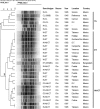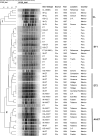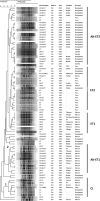Cholera between 1991 and 1997 in Mexico was associated with infection by classical, El Tor, and El Tor variants of Vibrio cholerae
- PMID: 20668130
- PMCID: PMC2953092
- DOI: 10.1128/JCM.00866-10
Cholera between 1991 and 1997 in Mexico was associated with infection by classical, El Tor, and El Tor variants of Vibrio cholerae
Abstract
Vibrio cholerae O1 biotype El Tor (ET), the cause of the current 7th pandemic, has recently been replaced in Asia and Africa by an altered ET biotype possessing cholera toxin (CTX) of the classical (CL) biotype that originally caused the first six pandemics before becoming extinct in the 1980s. Until recently, the ET prototype was the biotype circulating in Peru; a detailed understanding of the evolutionary trend of V. cholerae causing endemic cholera in Latin America is lacking. The present retrospective microbiological, molecular, and phylogenetic study of V. cholerae isolates recovered in Mexico (n = 91; 1983 to 1997) shows the existence of the pre-1991 CL biotype and the ET and CL biotypes together with the altered ET biotype in both epidemic and endemic cholera between 1991 and 1997. According to sero- and biotyping data, the altered ET, which has shown predominance in Mexico since 1991, emerged locally from ET and CL progenitors that were found coexisting until 1997. In Latin America, ET and CL variants shared a variable number of phenotypic markers, while the altered ET strains had genes encoding the CL CTX (CTX(CL)) prophage, ctxB(CL) and rstR(CL), in addition to resident rstR(ET), as the underlying regional signature. The distinct regional fingerprints for ET in Mexico and Peru and their divergence from ET in Asia and Africa, as confirmed by subclustering patterns in a pulsed-field gel electrophoresis (NotI)-based dendrogram, suggest that the Mexico epidemic in 1991 may have been a local event and not an extension of the epidemics occurring in Asia and South America. Finally, the CL biotype reservoir in Mexico is unprecedented and must have contributed to the changing epidemiology of global cholera in ways that need to be understood.
Figures



References
-
- Alam, M., M. Sultana, G. B. Nair, A. K. Siddique, N. A. Hasan, R. B. Sack, D. A. Sack, K. U. Ahmed, A. Sadique, H. Watanabe, C. J. Grim, A. Huq, and R. R. Colwell. 2007. Viable but nonculturable Vibrio cholerae O1 in biofilms in the aquatic environment and their role in cholera transmission. Proc. Natl. Acad. Sci. U. S. A. 104:17801-17806. - PMC - PubMed
-
- Blake, P. A. 1994. Endemic cholera in Australia and United States, p. 309-319. In I. K. Wachsmuth, P. A. Blake, and O. Olsvik (ed.), Vibrio cholerae and cholera: molecular to global perspectives. ASM Press, Washington, DC.
Publication types
MeSH terms
Substances
LinkOut - more resources
Full Text Sources
Medical

